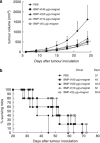Bacterial magnetic particles as a novel and efficient gene vaccine delivery system
- PMID: 22170341
- PMCID: PMC3520014
- DOI: 10.1038/gt.2011.197
Bacterial magnetic particles as a novel and efficient gene vaccine delivery system
Abstract
DNA vaccination is an attractive approach for eliciting antigen-specific immunity. In this study, we used magnetosomes (bacterial magnetic particles, BMPs) as carriers of a recombinant DNA composed of a secondary lymphoid tissue chemokine, human papillomavirus type E7 (HPV-E7) and Ig-Fc fragment (pSLC-E7-Fc) to generate a gene vaccine (BMP-V) for tumour immunotherapy. The results indicate that BMPs linked to DNA more efficiently in phosphate-buffered saline (pH=4-5) than in physiological saline. Efficient transfection of BMP-V in vitro and in vivo was achieved when a 600-mT static magnetic field was applied for 10 min. In a mouse tumour model, subcutaneous injection of BMP-V (5 μg, × 3 at 4-day intervals) plus magnetic exposure elicited systemic HPV-E7-specific immunity leading to significant tumour inhibition. The treated mice tolerated BMP-V immunisation well with no toxic side effects, as shown by histopathological examinations of major internal organs. Taken together, these results suggest that BMP can be used as a gene carrier to elicit a systemic immune response.
Figures











Similar articles
-
Enhancement of DNA vaccine potency by sandwiching antigen-coding gene between secondary lymphoid tissue chemokine (SLC) and IgG Fc fragment genes.Cancer Biol Ther. 2006 Apr;5(4):427-34. doi: 10.4161/cbt.5.4.2528. Epub 2006 Apr 20. Cancer Biol Ther. 2006. PMID: 16575207
-
DNA vaccines against HPV-16 E7-expressing tumour cells.Anticancer Res. 2003 Mar-Apr;23(2B):1449-54. Anticancer Res. 2003. PMID: 12820408
-
Induction of protective and therapeutic antitumour immunity using a novel tumour-associated antigen-specific DNA vaccine.Immunol Cell Biol. 2006 Oct;84(5):440-7. doi: 10.1111/j.1440-1711.2006.01453.x. Immunol Cell Biol. 2006. PMID: 16942487
-
Comparison of HPV DNA vaccines employing intracellular targeting strategies.Gene Ther. 2004 Jun;11(12):1011-8. doi: 10.1038/sj.gt.3302252. Gene Ther. 2004. PMID: 14985791
-
Recombined DNA vaccines encoding calreticulin linked to HPV6bE7 enhance immune response and inhibit angiogenic activity in B16 melanoma mouse model expressing HPV 6bE7 antigen.Arch Dermatol Res. 2006 Jul;298(2):64-72. doi: 10.1007/s00403-006-0659-z. Epub 2006 Apr 27. Arch Dermatol Res. 2006. PMID: 16710741
Cited by
-
Stimuli-responsive nanocarriers for drug delivery.Nat Mater. 2013 Nov;12(11):991-1003. doi: 10.1038/nmat3776. Nat Mater. 2013. PMID: 24150417 Review.
-
Preparation and in vitro antitumor effects of cytosine arabinoside-loaded genipin-poly-l-glutamic acid-modified bacterial magnetosomes.Int J Nanomedicine. 2015 Feb 17;10:1387-97. doi: 10.2147/IJN.S76123. eCollection 2015. Int J Nanomedicine. 2015. PMID: 25733831 Free PMC article.
-
Co-delivery of doxorubicin and recombinant plasmid pHSP70-Plk1-shRNA by bacterial magnetosomes for osteosarcoma therapy.Int J Nanomedicine. 2016 Oct 25;11:5277-5286. doi: 10.2147/IJN.S115364. eCollection 2016. Int J Nanomedicine. 2016. PMID: 27822032 Free PMC article.
-
Magnetosomes as Potential Nanocarriers for Cancer Treatment.Curr Drug Deliv. 2024;21(8):1073-1081. doi: 10.2174/1567201820666230619155528. Curr Drug Deliv. 2024. PMID: 37340750 Review.
-
Work Patterns of MamXY Proteins during Magnetosome Formation in Magnetospirillum gryphiswaldense MSR-1.Appl Environ Microbiol. 2019 Jan 9;85(2):e02394-18. doi: 10.1128/AEM.02394-18. Print 2019 Jan 15. Appl Environ Microbiol. 2019. PMID: 30367002 Free PMC article.
References
-
- Bansal A, Jackson B, West K, Wang S, Lu S, Kennedy JS, et al. Multifunctional T-cell characteristics induced by a polyvalent DNA prime/protein boost human immunodeficiency virus type 1 vaccine regimen given to healthy adults are dependent on the route and dose of administration. J Virol. 2008;8:6458–6469. - PMC - PubMed
-
- Donnelly J, Berry K, Ulmer JB. Technical and regulatory hurdles for DNA vaccines. Int J Parasitol. 2003;33:457–467. - PubMed
-
- Nicolas JF, Guy B. Intradermal, epidermal and transcutaneous vaccination: from immunology to clinical practice. Expert Rev Vaccines. 2008;7:1201–1214. - PubMed
-
- Bazylinski DA, Frankel RB. Magnetosome formation in prokaryotes. Nat Rev Microbiol. 2004;2:217–230. - PubMed
-
- Bazylinski DA, Garratt-Reed AR, Frankel B. Electron-microscopic studies of magnetosomes in magnetotactic bacteria. Microsc Res Techniq. 1994;27:389–401. - PubMed
Publication types
MeSH terms
Substances
Grants and funding
LinkOut - more resources
Full Text Sources

